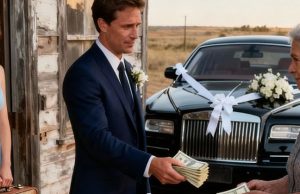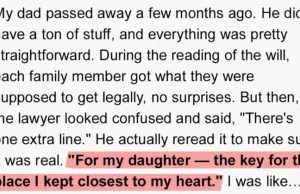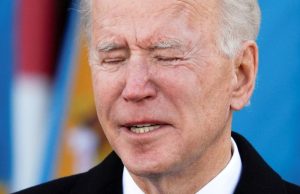
On a dreary autumn morning in the quiet town of Valea Veche, a lone dog appeared in the cemetery.
Its eyes, heavy with emotion, never strayed from the wooden cross planted in the soil.
“That’s Santa’s dog,” someone whispered. “Poor creature doesn’t realize his master’s not coming back.”
The townspeople were referring to Moș Gheorghe, fondly called “Santa Claus” for his white beard and kind eyes. He had lived alone on the outskirts of town, his only constant companion being Ursu, the loyal dog. Since Gheorghe’s funeral three days earlier, people assumed Ursu would wander off. But the dog never left.
Each day, Ursu returned to the same spot by the grave. He barely moved, ate very little, and kept a silent vigil. Some townsfolk brought food and water, but Ursu seemed uninterested. His sadness felt deeper than simple grief, like he knew something others didn’t.
“That’s what loyalty looks like,” the elders said. “He’ll stay there until his heart breaks.”

Maria, the local schoolteacher, passed the cemetery each morning on her way to work. She always stopped to speak to Ursu and left him something to eat. A week passed before she noticed a change. The dog had started digging near the grave. At first, it was slight. But soon, the digging became more focused.
“He must smell his master and wants to reach him,” someone speculated.
But Ursu’s digging only grew more intense. Morning and night, his paws tore at the ground. His fur was soiled, and his pads bled from the effort. Still, he returned again and again, as though he had a purpose.
One morning, Maria watched quietly and whispered, “Ursu, what are you trying to tell us?”
He didn’t pause. He just kept digging.
Soon, whispers spread around town. Some dismissed it as grief. Others felt uneasy. Maria returned that evening with her cousin, Deputy Tudor Lupu—a calm, reliable man. Though he hadn’t alerted his superiors, he sensed something was wrong.
Tudor examined the site. The wooden cross was unstable, and a strange smell rose from the disturbed ground.
“If this keeps up, we’ll need to open the grave,” he said.
Maria nodded solemnly. “Something isn’t right.”

The next morning, with the mayor’s hesitant approval and a county official present, they began to exhume the grave.
Ursu stepped back quietly, as if he had been waiting for this.
As the workers dug, the cemetery grew silent. No one spoke. When the coffin surfaced, it appeared scratched and uneven. Tudor lifted the lid carefully.
Inside was not Moș Gheorghe, but a middle-aged stranger, unknown to anyone. His shirt was bloodied, and bruises on his neck suggested he had been strangled.
“Who is this?” Tudor murmured in disbelief.
“But I buried Santa myself!” cried Dorel, the gravedigger. “I swear he was in that box!”
Maria looked at Ursu, now lying beside the grave. He wasn’t grieving—he looked calm, almost relieved.
Tudor ordered the house where Gheorghe had lived to be reopened. Inside, they found signs of a struggle—broken furniture, dried blood, but strangely, Gheorghe’s wallet and coat were left neatly on a chair.
Still, the old man was missing.
Speculation ran wild. Had Gheorghe been k!lled for money? Hidden away? And who was the man in the coffin?

Maria kept returning to the cemetery. Ursu was always there, no longer digging—just keeping watch.
Two weeks later, a hiker discovered a body wrapped in a blanket, hidden in the woods near the quarry. Though decomposed, a wallet inside confirmed the identity: Gheorghe Banu, 76 years old.
The real Santa Claus.
The investigators believed Gheorghe had been murdered and replaced with a stranger to hide the crime. Whoever did it never expected the dog to raise an alarm. Ursu had known all along. He wasn’t mourning—he was guarding the truth.
Ursu became a legend. Locals brought him food and blankets. A newspaper ran the headline: “The Dog Who Solved a Mystery.” Schoolchildren drew pictures of Ursu lying by the grave, calm and noble.
But fame meant nothing to him.
Every day, he returned to the spot where Gheorghe truly lay, now marked with a simple tombstone. There, Ursu stayed—no longer searching, just watching.
In Maria’s classroom, a framed photo of Ursu sat on the shelf beneath a handwritten quote:
“Some truths are never spoken. But they are guarded.”















